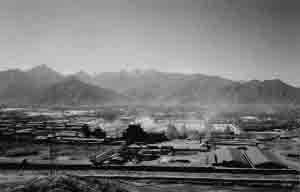
The Cuban dissident movement is a political movement in Cuba whose aim is to replace the current regime with a more democratic form of government. According to Human Rights Watch, the Cuban government represses nearly all forms of political dissent.

Drapchi Prison, or Lhasa Prison No. 1, is the largest prison in Tibet, China, located in Lhasa.
Social dangerousness or Pre-criminal danger to society is a legal charge under Cuban law which allows the authorities to detain people who they think are likely to commit crimes. The charge carries a penalty of up to four years in prison. The Cuban government has been accused by Amnesty International of using the charge almost exclusively against critics of the government.
Jorge Luis García Pérez is a human rights and democracy activist in Cuba.

Black Spring refers to the 2003 crackdown on Cuban dissidents. The government imprisoned 75 dissidents, that included 29 journalists, as well as librarians, human rights activists, and democracy activists, on the basis that they were acting as agents of the United States by accepting aid from the US government. Although Amnesty International adopted 75 Cubans as prisoners of conscience, according to Cuba "the 75 individuals arrested, tried and sentenced in March/April 2003 ... who were jailed are demonstrably not independent thinkers, writers or human rights activists, but persons directly in the pay of the US government ... those who were arrested and tried were charged not with criticizing the government, but for receiving American government funds and collaborating with U.S diplomats."
Luis Enrique Ferrer García is a Cuban dissident. He is married and has a daughter and a son.
Juan Adolfo Fernández Saínz is a Cuban journalist. Before his imprisonment, he was an independent journalist with the Patria news agency. Adolfo Fernández Sainz also contributed to foreign publications, particularly in Sweden. He was correspondent of the Russian human rights news agency Prima since 2001.

Darsi Ferrer Ramírez was a Cuban doctor, journalist, director of Juan Bruno Zayas Health and Human Rights Center, and also a dissident.
Adra Prison is a prison in Syria, on the north-east outskirts of Damascus. Political prisoners are held in the prison, along with a mixture of civil prisoners such as traffic offenders, murderers, and drug dealers. In 2014, the prison held more than 7,000 inmates, a dozen of them women, in space designed for 2,500. The Washington Post referred to the prison as "infamous".
Jesús Joel Díaz Hernández is a Cuban journalist who was imprisoned by the Cuban government from 1999-2001. His imprisonment attracted protest from several human rights organizations, including Amnesty International, which named him a prisoner of conscience.
Wilmar Villar Mendoza was a Cuban dissident. He was born around 1980. He married Maritza Pelegrino Cabrales and had two children. He lived in the Contramaestre area of Santiago de Cuba.
Félix Bonne Carcassés (1939-2017) was a Cuban engineering professor and dissident, best known for his 1997-2000 imprisonment as a member of the pro-democracy "Group of Four".
José Daniel Ferrer García is a Cuban human rights activist, whom the international and Spanish media claim to be "the visible head of the dissident movement in the interior of the island since the death of Oswaldo Payá, in July 2012”.

Normando Hernández González is a Cuban writer and journalist who now lives in the United States.
On July 26, 2010, seventeen prisoners from Ward 350 of Evin prison, Iran, executed a 16-day hunger strike to protest solitary confinement, as well as the poor living conditions within the prison. This included the lack of necessary medical treatment, arbitrary detention, denial of access to legal counsel, suspension of visitation privileges and abuse from prison guards. Subsequent to the hunger strike, authorities placed the seventeen prisoners in solitary confinement in Ward 240, while also prohibiting them from making phone calls, visiting their families, or contacting their lawyers. Overall, the action did not achieve its objectives of improving conditions within the prison or gaining access to legal counsel. However, one of the prisoners on strike, Babak Bordbar, was released for unknown reasons on August 10.











